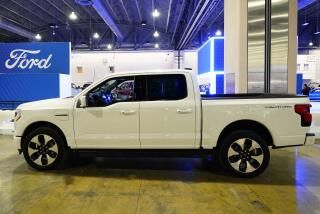Saturday Drive: 2012 Aston Martin DBS Carbon Edition Volante

The car: 2012 Aston Martin DBS Carbon Edition Volante
The power: 510 horsepower and 420 pound-feet of torque from a 6.0-liter, naturally-aspirated V-12 engine. Power is routed to the rear wheels through a carbon fiber propeller shaft via a six-speed automatic transmission with carbon-fiber-tipped magnesium shift paddles. A six-speed manual transmission is also available.
The photos: 2012 Aston Martin DBS Carbon Edition Volante
The speed: Zero to 60 mph in 4.3 seconds en route to a 190 mph top speed
The price: $304,291 including destination and a $2,600 gas guzzler tax. As tested: $305,311
The details: Like countless doyennes of Hollywood’s elite, Aston Martin’s aging DBS Volante (fancy-speak for convertible) gets a pinch of new life breathed into it with the Carbon Edition.
The Carbon Edition gives you special 20-inch rims with a 10-spoke design; carbon fiber mirror housings, trim in the taillights, and throughout the cabin; an exclusive seven-layer paint job that’s finished in a 25-hour polishing process; and semi-aniline leather that, quite frankly, smells like heaven. In fact, all late-model Aston Martins do. If they made a cologne that smelled like the inside of a new Aston, I’d probably stop bathing altogether and just wear that. Next time you see an Aston Martin in the parking lot, ask the owners if you can smell the inside of their car. Of course they won’t think you’re weird.
If the DBS itself looks familiar, it should. The car into which all this carbon and leather trickery was dumped is a bit of a starlet itself, having played an integral role in the 2006 James Bond film “Casino Royale,” which introduced Daniel Craig to the role.
It’s probably the best-looking thing in the film that Bond didn’t try to stick with his Walther P99, though the car follows in its driver’s footsteps and gets decidedly trashed in several scenes.
The regular DBS was made available to customers in 2007, and the Volante version was introduced in 2009. Throughout the car’s lifespan, it’s been powered by the V-12 that’s mated to the six-speed automatic transmission. It seats two in the front and has two small prisons masquerading as seats in the back. Don’t put humans back there.
The DBS’ suspension system and the traction control each have a track (or sport) mode, and drivers can also use a third “Sport” button that sharpens throttle response, decreases the transmission’s shift times and opens up the exhaust for more voluminous sound above 3,700 rpm. Recent upgrades to all DBS versions include standard carbon ceramic brakes and a Garmin-based navigation system.
The drive: Though its power output of 510 horsepower and 420 pound-feet of torque may seem like sports car numbers, it’s important to remember the DBS is a large, grand-touring car. If you want lithe and nimble, look up Aston’s smaller Vantage V-8 or V-12.
But keeping the DBS’ modus operandi in mind, the car is a thoroughly well-bred touring car. Curb weight is 3,836 pounds, and it handles this weight well, remaining securely planted through turns but never cumbersome. Long-range, high-speed cruising is what this car does best (hence the grand-touring tag).
In normal mode the car is relatively quiet and demure, content with being seen (something it’s very good at) and not heard. What you do hear is a bit of wind noise coming from those carbon-fiber-shrouded mirrors and seeping in through the roof when it’s up.
This Aston’s basic design is getting a little old, an issue not helped by the fact that nearly every other Aston product looks very similar. Good thing then, that this oft-replicated look is gorgeous, seductive and strong. Driving it while wearing anything less than an Anderson & Sheppard suit feels like you’re committing some grave injustice.
But if you’re a fan of a stout V-12 engine (you are, trust me), this car will be heard in Sport mode. Put that transmission in manual mode and wait for the engine to crest that 3,700-rpm threshold and you (and those within a city block of you) are treated to a malevolent trumpeting not unlike the brass section in an orchestra from hell. What adds to the enjoyment of this aural conflagration is how the motor in this DBS maintains its British sensibilities and doesn’t scream and thrash like a high-strung motor from Italy might.
Unfortunately, this loyalty to style also means the interior controls are there to look good first and function second. The navigation screen rises out of the dash like a carbon-fiber-topped monolith, but the Garmin system it houses is worthy of a Kmart Blue Light Special. It feeling like an afterthought is only exacerbated by the fact that none of the car’s other functions (including those for the excellent 1,000-watt Bang & Olufsen sound system) can be accessed via that screen. You have to use a different outdated (and tiny) screen in the dashboard for that.
The DBS Carbon also shows its age with its six-speed transmission. It’s been good to the DBS since 2007, but in an era of super-fact dual-clutch transmissions or automated manuals, the lack of crispness and immediacy is becoming more apparent.
The takeaway: Age can’t limit inimitable sound or design.







